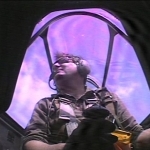Plane basics – Bevel up or down on #4, #5 and #7 planes

I have standard Stanley/Bailey iron planes – #4, #5 and #7. Are the irons supposed to be bevel up or bevel down on these? I believe I ead that for the smoother, it shoudl eb bevel down. Is that correct?
What abotu the #4 and #7? Is there a rule of thumb? Or for each of these planes, do you use bevel up in certain conditions and bevel down in another?
Also if you will be planing both hardwoods and softwoods, what is a reasonable bevel angle?
thanks!
Gregg















Replies
Some General Info
Generally speaking, all standard handplanes are designed to work with the bevel down, thus allowing the chipbreaker (the curved plate with the big flat screw) to be positioned close to the cutting edge for maximum support and chipbreaking action. Planes designed for bevel up use generally to not have a chipbreaker and instead have a much thicker blade; they also have a lower blade angle since it's the degree of bevel that establishes the true cutting angle. Most standard planes have cutting angles around 45 degrees. More advanced planes, like infill smoothers and lie nielsen types may offer higher cutting angles, but you can simulate the effect by adding a back-bevel to your blade. The advantage of a higher cutting angle is less tearout on highly figured woods, but 45 degrees is adequate for most planing tasks as long as you learn to read grain direction and go the right way.
Something else you should realize if you're new to planes, is that you will have a pretty much miserable experience with them until you learn to sharpen the blade to a razor's edge and fine tune all the adjustments. Once you get this mastered they are a real joy to use. My first handplane was a plastic handled monstrosity from a pawn shop that destroyed its test board. I almost swore off handtools until I happened across a vintage stanley from around 1900. After a careful restoration and the improvement of my sharpening technique I was taking off whisper thin shavings with no tearout. I've never looked back!
All standard Bailey adjuster planes have the iron bevel down
Gregg:
As the other replier said, the #4, #5, and #7 are all to be setup with the bevel down. The #4 is your smoothing plane to give boards a final finish (think very fine shavings). The #5 is your fore plane to be used to get rough boards squared up and at nearly the final thickness you want (leave the boards fat for final flattening with the #7 and smoothing with the #4). The #7 is your jointer/try plane and is used to get the long edges of two boards perfectly straight for gluing them together to form panels plus flattening the panel after glue up. I suggest you get a copy of Christopher Schwarz's book "Handplane Essentials". It it the best primer on using handplanes I know of. He also has some videos on using planes and other hand tools (Chris writes better than he talks. The videos are slow, but have good information). If you are a paying member of the Fine Woodworking website there are also several articles on handplanes that you should find useful.
gdblake
This forum post is now archived. Commenting has been disabled